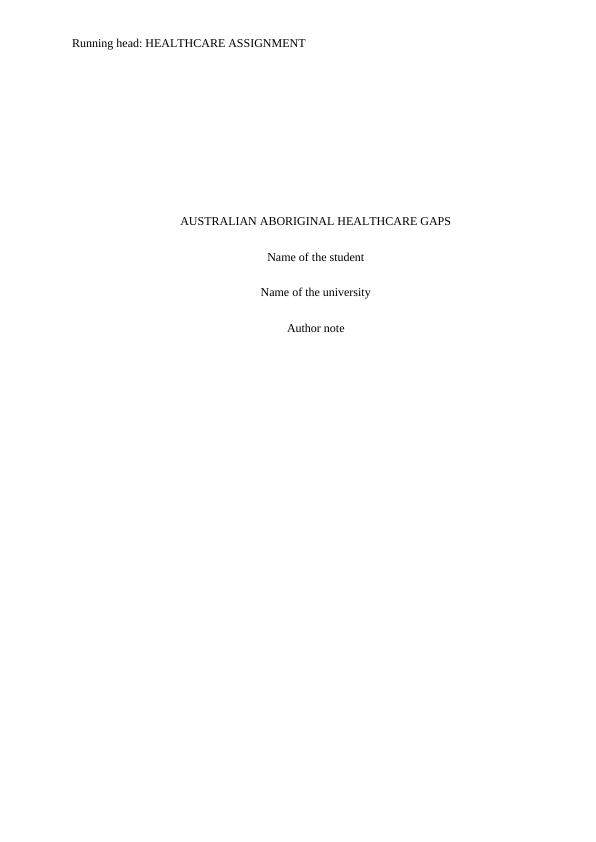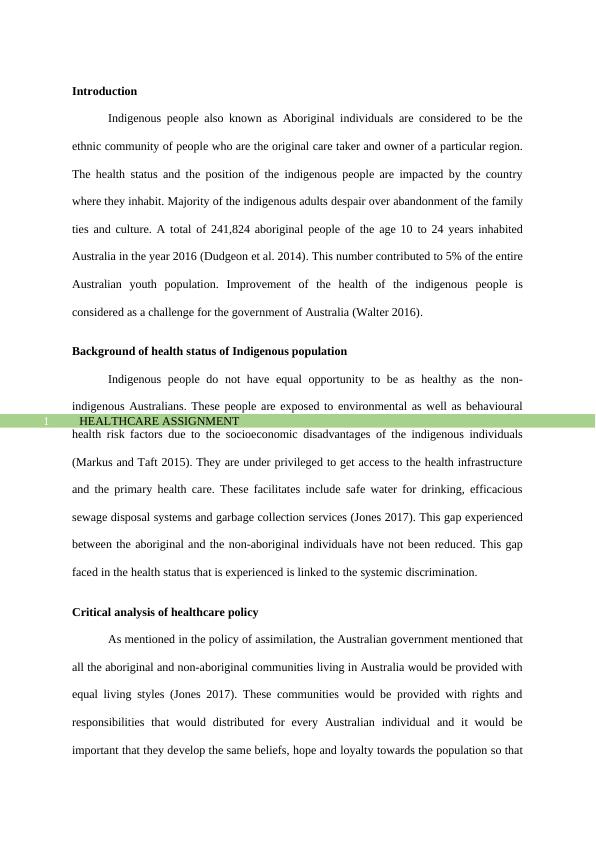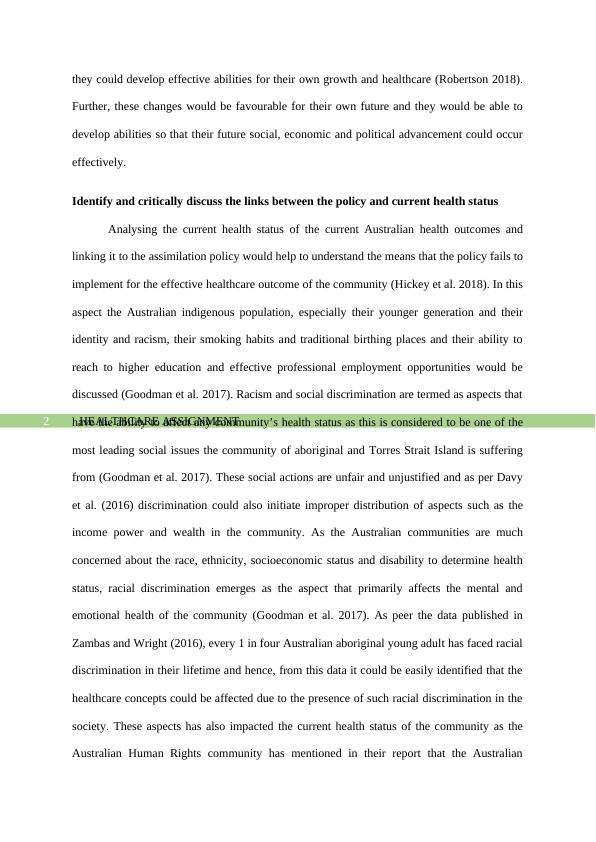Australian Aboriginal Healthcare Gaps
Added on 2022-11-09
12 Pages3421 Words227 Views
Running head: HEALTHCARE ASSIGNMENT
AUSTRALIAN ABORIGINAL HEALTHCARE GAPS
Name of the student
Name of the university
Author note
AUSTRALIAN ABORIGINAL HEALTHCARE GAPS
Name of the student
Name of the university
Author note

HEALTHCARE ASSIGNMENT1
Introduction
Indigenous people also known as Aboriginal individuals are considered to be the
ethnic community of people who are the original care taker and owner of a particular region.
The health status and the position of the indigenous people are impacted by the country
where they inhabit. Majority of the indigenous adults despair over abandonment of the family
ties and culture. A total of 241,824 aboriginal people of the age 10 to 24 years inhabited
Australia in the year 2016 (Dudgeon et al. 2014). This number contributed to 5% of the entire
Australian youth population. Improvement of the health of the indigenous people is
considered as a challenge for the government of Australia (Walter 2016).
Background of health status of Indigenous population
Indigenous people do not have equal opportunity to be as healthy as the non-
indigenous Australians. These people are exposed to environmental as well as behavioural
health risk factors due to the socioeconomic disadvantages of the indigenous individuals
(Markus and Taft 2015). They are under privileged to get access to the health infrastructure
and the primary health care. These facilitates include safe water for drinking, efficacious
sewage disposal systems and garbage collection services (Jones 2017). This gap experienced
between the aboriginal and the non-aboriginal individuals have not been reduced. This gap
faced in the health status that is experienced is linked to the systemic discrimination.
Critical analysis of healthcare policy
As mentioned in the policy of assimilation, the Australian government mentioned that
all the aboriginal and non-aboriginal communities living in Australia would be provided with
equal living styles (Jones 2017). These communities would be provided with rights and
responsibilities that would distributed for every Australian individual and it would be
important that they develop the same beliefs, hope and loyalty towards the population so that
Introduction
Indigenous people also known as Aboriginal individuals are considered to be the
ethnic community of people who are the original care taker and owner of a particular region.
The health status and the position of the indigenous people are impacted by the country
where they inhabit. Majority of the indigenous adults despair over abandonment of the family
ties and culture. A total of 241,824 aboriginal people of the age 10 to 24 years inhabited
Australia in the year 2016 (Dudgeon et al. 2014). This number contributed to 5% of the entire
Australian youth population. Improvement of the health of the indigenous people is
considered as a challenge for the government of Australia (Walter 2016).
Background of health status of Indigenous population
Indigenous people do not have equal opportunity to be as healthy as the non-
indigenous Australians. These people are exposed to environmental as well as behavioural
health risk factors due to the socioeconomic disadvantages of the indigenous individuals
(Markus and Taft 2015). They are under privileged to get access to the health infrastructure
and the primary health care. These facilitates include safe water for drinking, efficacious
sewage disposal systems and garbage collection services (Jones 2017). This gap experienced
between the aboriginal and the non-aboriginal individuals have not been reduced. This gap
faced in the health status that is experienced is linked to the systemic discrimination.
Critical analysis of healthcare policy
As mentioned in the policy of assimilation, the Australian government mentioned that
all the aboriginal and non-aboriginal communities living in Australia would be provided with
equal living styles (Jones 2017). These communities would be provided with rights and
responsibilities that would distributed for every Australian individual and it would be
important that they develop the same beliefs, hope and loyalty towards the population so that

HEALTHCARE ASSIGNMENT2
they could develop effective abilities for their own growth and healthcare (Robertson 2018).
Further, these changes would be favourable for their own future and they would be able to
develop abilities so that their future social, economic and political advancement could occur
effectively.
Identify and critically discuss the links between the policy and current health status
Analysing the current health status of the current Australian health outcomes and
linking it to the assimilation policy would help to understand the means that the policy fails to
implement for the effective healthcare outcome of the community (Hickey et al. 2018). In this
aspect the Australian indigenous population, especially their younger generation and their
identity and racism, their smoking habits and traditional birthing places and their ability to
reach to higher education and effective professional employment opportunities would be
discussed (Goodman et al. 2017). Racism and social discrimination are termed as aspects that
have the ability to affect any community’s health status as this is considered to be one of the
most leading social issues the community of aboriginal and Torres Strait Island is suffering
from (Goodman et al. 2017). These social actions are unfair and unjustified and as per Davy
et al. (2016) discrimination could also initiate improper distribution of aspects such as the
income power and wealth in the community. As the Australian communities are much
concerned about the race, ethnicity, socioeconomic status and disability to determine health
status, racial discrimination emerges as the aspect that primarily affects the mental and
emotional health of the community (Goodman et al. 2017). As peer the data published in
Zambas and Wright (2016), every 1 in four Australian aboriginal young adult has faced racial
discrimination in their lifetime and hence, from this data it could be easily identified that the
healthcare concepts could be affected due to the presence of such racial discrimination in the
society. These aspects has also impacted the current health status of the community as the
Australian Human Rights community has mentioned in their report that the Australian
they could develop effective abilities for their own growth and healthcare (Robertson 2018).
Further, these changes would be favourable for their own future and they would be able to
develop abilities so that their future social, economic and political advancement could occur
effectively.
Identify and critically discuss the links between the policy and current health status
Analysing the current health status of the current Australian health outcomes and
linking it to the assimilation policy would help to understand the means that the policy fails to
implement for the effective healthcare outcome of the community (Hickey et al. 2018). In this
aspect the Australian indigenous population, especially their younger generation and their
identity and racism, their smoking habits and traditional birthing places and their ability to
reach to higher education and effective professional employment opportunities would be
discussed (Goodman et al. 2017). Racism and social discrimination are termed as aspects that
have the ability to affect any community’s health status as this is considered to be one of the
most leading social issues the community of aboriginal and Torres Strait Island is suffering
from (Goodman et al. 2017). These social actions are unfair and unjustified and as per Davy
et al. (2016) discrimination could also initiate improper distribution of aspects such as the
income power and wealth in the community. As the Australian communities are much
concerned about the race, ethnicity, socioeconomic status and disability to determine health
status, racial discrimination emerges as the aspect that primarily affects the mental and
emotional health of the community (Goodman et al. 2017). As peer the data published in
Zambas and Wright (2016), every 1 in four Australian aboriginal young adult has faced racial
discrimination in their lifetime and hence, from this data it could be easily identified that the
healthcare concepts could be affected due to the presence of such racial discrimination in the
society. These aspects has also impacted the current health status of the community as the
Australian Human Rights community has mentioned in their report that the Australian

HEALTHCARE ASSIGNMENT3
aboriginal community is still suffering from their critical health complication associated with
the health complication due to social inequality and gaps (Street et al. 2018). The report
mentioned that Australian indigenous population has not been provided with equal
opportunity as other Australian communities to attain healthy lifestyle and hence, their socio
economic and physiological aspects have become primary reasons of their healthcare
complication (Marsden 2018). Hence, from this critical analysis of the Assimilation Policy
1961 helped to understand the fact that this policy and its loopholes are the primary reason of
the widespread health inequality in the process and the government should be able to
implement inclusive strategies so that all the communities in Australian could help each other
to develop effective health outcome for every community (Jones 2017).
The Australian healthcare system not only discriminates the younger generation of the
Australia and affect their health status but also impacts the new born babies and their mothers
by making their health outcome stagnant and increasing their risk of infections. There are
aspects that have identified the persisting complications of health status of the Australian
aboriginal birth rate and the way this birth rate has impacted the healthcare of the community
(Hickey et al. 2018). Maternal mortality is three times higher in this community, with which
this community has 12% lower birth weight, 14% preterm birth, 12% perinatal deaths and
others, Besides this, it was also identified from the research of Gould et al. (2017) that the
smoking rate is also higher in this community than others. Therefore, from this discussion it
was identified that the government has failed to implement healthy maternity and birth
related provisions in this community due to which all these complications are still associated
with community and its community members. The aboriginal people experience disadvantage
in the socio-economic aspect like the employment rate of the non-indigenous Australians was
three times higher than the indigenous Australians. Their average gross household income is
also lesser in comparison to the no-indigenous people in Australia (Markus and Taft 2015).
aboriginal community is still suffering from their critical health complication associated with
the health complication due to social inequality and gaps (Street et al. 2018). The report
mentioned that Australian indigenous population has not been provided with equal
opportunity as other Australian communities to attain healthy lifestyle and hence, their socio
economic and physiological aspects have become primary reasons of their healthcare
complication (Marsden 2018). Hence, from this critical analysis of the Assimilation Policy
1961 helped to understand the fact that this policy and its loopholes are the primary reason of
the widespread health inequality in the process and the government should be able to
implement inclusive strategies so that all the communities in Australian could help each other
to develop effective health outcome for every community (Jones 2017).
The Australian healthcare system not only discriminates the younger generation of the
Australia and affect their health status but also impacts the new born babies and their mothers
by making their health outcome stagnant and increasing their risk of infections. There are
aspects that have identified the persisting complications of health status of the Australian
aboriginal birth rate and the way this birth rate has impacted the healthcare of the community
(Hickey et al. 2018). Maternal mortality is three times higher in this community, with which
this community has 12% lower birth weight, 14% preterm birth, 12% perinatal deaths and
others, Besides this, it was also identified from the research of Gould et al. (2017) that the
smoking rate is also higher in this community than others. Therefore, from this discussion it
was identified that the government has failed to implement healthy maternity and birth
related provisions in this community due to which all these complications are still associated
with community and its community members. The aboriginal people experience disadvantage
in the socio-economic aspect like the employment rate of the non-indigenous Australians was
three times higher than the indigenous Australians. Their average gross household income is
also lesser in comparison to the no-indigenous people in Australia (Markus and Taft 2015).

End of preview
Want to access all the pages? Upload your documents or become a member.
Related Documents
Health Care of Aboriginals and Torres Strait Islanderslg...
|12
|3195
|7
Policy of Assimilation 1961: Impact on Health Outcomes of Australian Indigenous Young Peopleslg...
|13
|3460
|255
Closing the Gap: A Policy for Improving Indigenous Health in Australialg...
|8
|1408
|267
Health Disparities and Cultural Competent Care for Australian Aboriginalslg...
|9
|2384
|74
How's Your Sugar? - A Website for Indigenous People with Diabeteslg...
|5
|1281
|58
Indigenous Education and Perspectives Quiz Questions 2022lg...
|4
|508
|21
